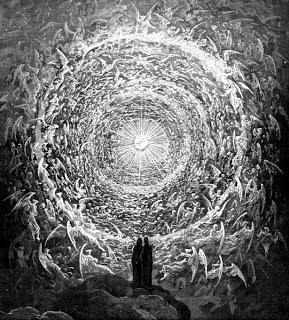
Dante and the Divine (Gustav Doré)
I recently finished teaching Dante's Divine Comedy. Predictably, I made much of how the poem uses music. Hell has only unholy noise: crashing stones, groans, shouts, and, famously, a demon who "made a trumpet of his ass" in Inferno 21. When Dante and Virgil finally make it to Purgatory, they are welcomed with the blessedly familiar sounds of the Te Deum. Unsurprisingly, Paradise features the poem's most dense and ecstatic music. As Dante ascends further into heavenly light and heavenly truth, he is also, increasingly, surrounded by singing. Dante's paradise is filled not only with "the glory of the One who moves the universe" (Paradiso I:1-2) but with saints who dance for joy, and angels who sing in more-than-human voices. The music of Dante's Paradise is dense, sweet, and unlike anything he has ever heard, though it often sets liturgical texts that he knows very well.Thanks to a student, I recently learned that the Swiss composer Helena Winckelman has taken on the challenge of imagining and creating music for Dante's quintessentially indescribable Paradise. 18 voices, an unsurprising harp, and a delightfully surprising contrabass clarinet sing melodies that, especially at the beginning, circle each other like the circles of Paradise. In the close textures of the music -- several sets of harmonies overlapping with each other, sometimes with combination tones -- there is something of a sense of human incapability. Winckelman's use of spectral composition techniques is not only an aural adventure; it's also a homage to Dante. Turning light into language is what Dante is doing throughout Paradiso, trying to express the inexpressible, pushing his chosen medium of expression to its limits.
Winckelman's setting of Paradiso 33 deliberately challenges the ear. This seems, to me, entirely apt for the conclusion of Paradiso, where Dante reaches the uncreated light at the heart of all things. The mystical chanting of the piece's opening gives way to a countertenor solo for the hymn to the Virgin that opens the canto. Throughout the piece, nearly-unintelligible sound can suddenly be resolved into an ecstatic, familiar cry of prayer or adoration. The transformation of Dante's vision ("ché la mia vista, venendo sincera") is marked with a great change within the music, accompanied by percussion. But Dante's vision of paradise is an experience always partial and imperfect, as he is acutely and painfully aware. His sense of loss and longing is poignantly set by Winkelman, notably in the repeated "non riede," as Dante explains -- laments -- that his recollections are faint and imperfect. As Dante comes closer and closer to the Divine, which he can never fully comprehend and with which he is yet one, Winckelman increasingly alludes to medieval music. She incorporates Gregorian chant and, at the work's climax, "Alle, psallite cum luya." This playful, joyful round, dating to Dante's lifetime, can be learnt in a matter of minutes. I found myself not only moved with the pleasure of finding a familiar tune in an unexpected place, but charmed by Winckelman's vision of complexity being resolved into simplicity, mystification into delight.

